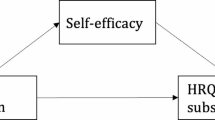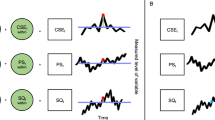Abstract
The present pilot study investigates the relationship between general self-efficacy (GSE) and sleep behavior in school-age children (between 5 and 10 years). Children with chronic insomnia (n = 54) had significantly lower GSE scores (p < 0.001) compared to a sample of healthy school-age children (n = 54) matched concerning age (M = 7.5 years) and gender (59.3 % boys, 40.7 % girls). In general, higher sleep disturbance scores were associated with lower GSE (r s = −0.37, p < 0.001). The highest negative correlations with GSE were found for frequent night wakings (r s = −0.38, p < 0.001), sleep anxiety (r s = −0.35, p < 0.001), and sleep onset delay (r s = −0.30, p < 0.01). In a multiple stepwise regression model, frequency of night wakings (ß = −0.33, p < 0.01) and sleep onset delay (ß = −0.26, p < 0.01) predicted GSE scores of children; sleep parameters accounted for 20 % of the variance in GSE scores. All in all, the present findings provide evidence for an association between GSE and sleep behavior, which are in line with previous results in other age groups and concerning other psychological constructs, e. g., depression and anxiety. Future studies should further investigate this topic in order to improve effective intervention programs for children.
Zusammenfassung
Die vorliegende Pilotstudie untersucht den Zusammenhang zwischen der allgemeinen Selbstwirksamkeitserwartung (SWE) und dem Schlafverhalten bei Kindern im Grundschulalter (zwischen 5 und 10 Jahren). Kinder mit chronischer Insomnie (n = 54) zeigten im Vergleich zu einer hinsichtlich Alter (M = 7,5 Jahre) und Geschlechtsverteilung (59,3 % Jungen, 40,7 % Mädchen) übereinstimmenden Gruppe von gesunden Grundschulkindern (n = 54) signifikant geringere SWE-Werte (p < 0,001). Höhere Schlafstörungswerte gingen mit einer geringeren SWE einher (r s = −0,37; p < 0,001). Die stärksten negativen Korrelationen mit der SWE zeigten sich für häufiges nächtliches Erwachen (r s = −0,38; p < 0,001), schlafbezogene Ängste (r s = −0,35, p < 0,001) und Einschlafverzögerungen (r s = −0,30; p < 0,01). In einem multiplen schrittweisen Regressionsmodell ließen sich die SWE-Werte der Kinder aus der Häufigkeit nächtlichen Erwachens (β = −0,33; p < 0,01) und dem Ausmaß an Einschlafverzögerungen (β = −0,26; p < 0,01) vorhersagen. Die Schlafparameter klärten dabei 20 % der Varianz der SWE-Werte auf. Die vorliegenden Ergebnisse stimmen mit bisherigen Befunden für andere Altersgruppen und andere psychologische Konstrukte (z. B. Depressionen und Ängste) überein und deuten insgesamt auf einen Zusammenhang zwischen der SWE und dem Schlafverhalten hin. Weiterführende Studien sollten diesen Zusammenhang näher untersuchen, nicht zuletzt, um effektive Interventionsprogramme für Kinder zu verbessern.
Similar content being viewed by others
References
Alfano CA, Ginsburg GS, Kingery JN (2007) Sleep-related problems among children and adolescents with anxiety disorders. J Am Acad Child Adolesc Psychiatry 46(2):224–232
American Academy of Sleep Medicine (AASM) (2014) International classification of sleep disorders (ICSD-3, 3rd edn. American Academy of Sleep Medicine (AASM), Darien, IL
Bandura A (1977) Self-efficacy: Toward a unifying theory of behavioral change. Psychol Rev 84(2):191
Bandura A (1997) Self-efficacy: The exercise of self-control. Freeman, New York
Bandura A, Pastorelli C, Barbaranelli C, Caprara GV (1999) Self-efficacy pathways to childhood depression. J Pers Soc Psychol 76(2):258
Bruni O, Russo P, Ferri R, Novelli L, Galli F, Guidetti V (2008) Relationships between headache and sleep in a non-clinical population of children and adolescents. Sleep Med 9(5):542–548
Forbes EE, Bertocci MA, Gregory AM, Ryan ND, Axelson DA, Birmaher B, Dahl RE (2008) Objective sleep in pediatric anxiety disorders and major depressive disorder. J Am Acad Child Adolesc Psychiatry 47(2):148–155
Griggs MS, Rimm-Kaufman SE, Merritt EG, Patton CL (2013) The Responsive Classroom approach and fifth grade students’ math and science anxiety and self-efficacy. Sch Psychol Q 28(4):360
Hinz A, Schumacher J, Albani C, Schmid G, Brähler E (2006) Bevölkerungsrepräsentative Normierung der Skala zur Allgemeinen Selbstwirksamkeitserwartung. Diagnostica 52(1):26–32
Hoffman B (2010) “I think I can, but I’m afraid to try”: The role of self-efficacy beliefs and mathematics anxiety in mathematics problem-solving efficiency. Learn Individ Differ 20(3):276–283
Jain S, Dowson M (2009) Mathematics anxiety as a function of multidimensional self-regulation and self-efficacy. Contemp Educ Psychol 34(3):240–249
Luszczynska A, Gutiérrez-Doña B, Schwarzer R (2005) General self-efficacy in various domains of human functioning: Evidence from five countries. Int J Psychol 40(2):80–89
Muris P (2002) Relationships between self-efficacy and symptoms of anxiety disorders and depression in a normal adolescent sample. Pers Individ Dif 32(2):337–348
Owens J, Spirito A, McGuinn M (2000) The Children’s Sleep Habits Questionnaire (CSHQ): Psychometric properties of a survey instrument for school-aged children. Sleep 23(3):1043–1052
Roberts RE, Roberts CR, Chen IG (2002) Impact of insomnia on future functioning of adolescents. J Psychosom Res 53(1):561–569
Rudy BM, Davis TE, Matthews RA (2012) The relationship among self-efficacy, negative self-referent cognitions, and social anxiety in children: A multiple mediator model. Behav Ther 43(3):619–628
Sadeh A, McGuire JP, Sachs H, Seifer R, Tremblay A, Civita R, Hayden RM (1995) Sleep and psychological characteristics of children on a psychiatric inpatient unit. J Am Acad Child Adolesc Psychiatry 34(6):813–819
Sanders MR, Woolley M (2005) The relationship between maternal self-efficacy and parenting practices: Implications for parent training. Child Care Health Dev 31(1):65–73
Schlarb, A. (2014). KiSS-Therapeutenmanual. Das Training für Kinder von 5–10 Jahren mit Schlafstörungen.
Schlarb A, Bihlmaier I, Hautzinger M, Gulewitsch MD, Schwerdtle B (2016) Nightmares and associations with sleep quality and self-efficacy among university students. J Sleep Disord Manag 1:2
Schlarb A, Schwerdtle B, Hautzinger M (2010) Validation and psychometric properties of the German version of the Children’s Sleep Habits Questionnaire (CSHQ-DE). Somnologie Schlafforsch Schlafmed 14(4):260–266
Schlarb A, Jaeger S, Schneider S, In-Albon T, Hautzinger M (2015) Sleep problems and separation anxiety in preschool-aged children: A path analysis. J Child Fam Stud 25(3):1–9
Schlarb AA, Kulessa D, Gulewitsch MD (2012) Sleep characteristics, sleep problems, and associations of self-efficacy among German university students. Nat Sci Sleep 4:1–7. doi:10.2147/nss.s27971
Scholz U, Doña BG, Sud S, Schwarzer R (2002) Is general self-efficacy a universal construct? Psychometric findings from 25 countries. Eur J Psychol Assess 18(3):242
Schwarzer R, Jerusalem M (1995) Generalized self-efficacy scale. In: Weinman J, Wright S, Johnson M (eds) Measures in health psychology: A user’s portfolio. NFER-NELSON, Windsor, pp 35–37 (Casual and control beliefs)
Schwarzer R, Jerusalem M (1999) Skalen zur Erfassung von Lehrer-und Schülermerkmalen. Dokumentation der psychometrischen Verfahren im Rahmen der Wissenschaftlichen Begleitung des Modellversuchs Selbstwirksame Schulen. Schwarzer und Jerusalem, Berlin
Teti DM, Gelfand DM (1991) Behavioral competence among mothers of infants in the first year: The mediational role of maternal self-efficacy. Child Dev 62(5):918–929
Verhage ML, Oosterman M, Schuengel C (2013) Parenting self-efficacy predicts perceptions of infant negative temperament characteristics, not vice versa. J Fam Psychol 27(5):844
World Health Organisation (2004) The ICD-10 classification of mental and behavioural disorders. Clinical descriptions and diagnostic guidelines. WHO, Genf
Author information
Authors and Affiliations
Corresponding author
Ethics declarations
Conflict of interest
I. Bihlmaier and A.A. Schlarb declare that they have no competing interests.
This article does not contain any studies with human participants or animals performed by any of the authors.
Rights and permissions
About this article
Cite this article
Bihlmaier, I., Schlarb, A.A. Self-efficacy and sleep problems. Somnologie 20, 275–280 (2016). https://doi.org/10.1007/s11818-016-0085-1
Received:
Accepted:
Published:
Issue Date:
DOI: https://doi.org/10.1007/s11818-016-0085-1




